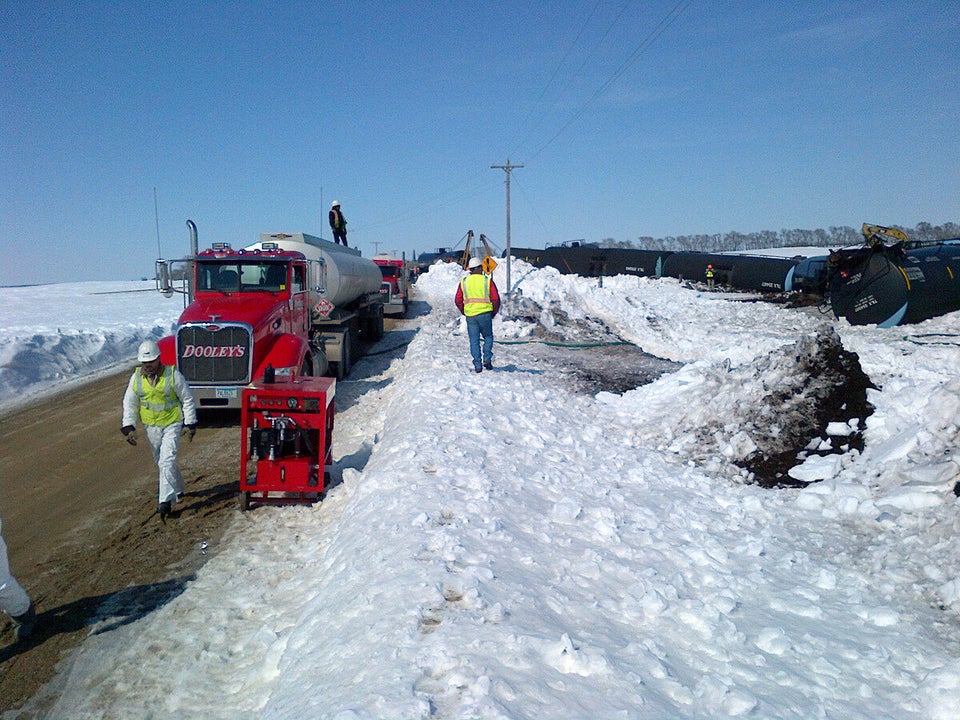
As the oil and gas industry faces increased hardship to get approval for new pipelines, some are turning to train tracks to solve the transportation problem.
Calgary-based Gibson Energy announced plans to develop a crude rail terminal near Hardisty, Alberta on Tuesday, to accommodate increasing Canadian production.
Developed in partnership with U.S. Development Group LLC (USDG), the terminal will be served by Canadian Pacific Railway.
"The Hardisty Rail Terminal will give Canadian oil producers flexibility to obtain the best value for their product and refiners expanded access to price advantaged crude oil supplies," said Mike Day, USDG's vice president.
The announcement comes just a week after plans for the Alberta Crude Terminal, a new facility near Edmonton, were announced.
The Hardisty Rail Terminal will have an initial capacity of 140,000 barrels of crude per day. It will handle two trains per day of up to 120 rail cars each and is targeted to begin operation in 2014.
Concerns over transporting crude by rail were intensified after an oil train derailment in Quebec that killed 47 people.
The runaway train carrying 72 carloads of crude derailed, hurtled down an incline and slammed into downtown Lac-Megantic where several cars exploded.
Canadian transportation authorities banned one-man crews for trains with dangerous goods last month, responding to calls for tougher regulations after the tragedy.
"The disaster brought to light several industry practices which have caused some concern," said Gerard McDonald, assistant deputy minister of safety and security at Transport Canada.
The Lac-Megantic derailment occurred less than two weeks after a train carrying petroleum product derailed on a Calgary bridge, as the city dealt with the aftermath of the devastating June flood.
Emergency crews worked to pump all of the oil products off six tanker cars that were teetering on the broken bridge and Calgary Mayor Naheed Nenshi lashed out at the railway, saying he had concerns about the timing of the bridge inspection in relation to flooding that swamped the city.
Canadian Pacific Railway has had at least six derailments since March this year, three of which spilled oil.
Rail and pipelines play different roles in getting crude oil to market but increased pressure on pipeline approvals has seen companies investing more in rail transport.
While pipelines - many of which have been delayed amid fervent environmental opposition and political wrangling - are seen as a stable, long-term solution, rail is seen as a flexible stop-gap measure and a way to tap into markets that aren't served by pipelines.
"I don't think anyone in the oilpatch was thinking that rail was going to be sort of the ideal full, long-term solution for getting products to market, getting oil to market," said Dylan Jones of the Canada West Foundation think-tank.
"It's clearly been playing a really critical role in dealing with what happens while pipelines are getting approved."
Cenovus Energy is also aiming to ship 10,000 barrels of oil per day by rail this year and increase that to 30,000 barrels a year later, as the fates of contentious pipeline projects remain undecided, according to chief executive Brian Ferguson.
He called the deadly July train derailment in Lac-Megantic, Que., "truly a very tragic situation," and said that safety in all of the company's operations were of paramount importance.
Gibson Energy has already secured four companies who will use the terminal to ship 100,000 barrels of oil per day.
With files from The Canadian Press
Also on HuffPost
